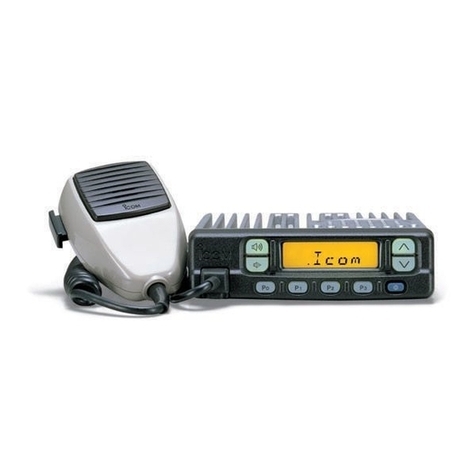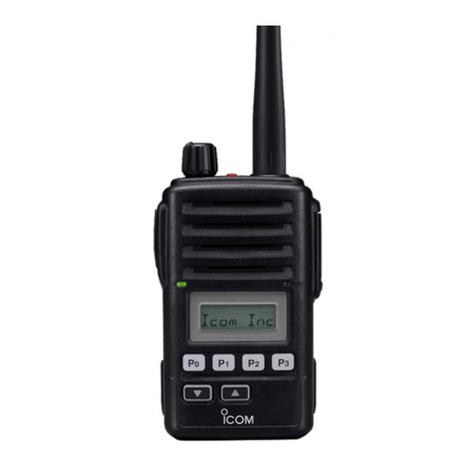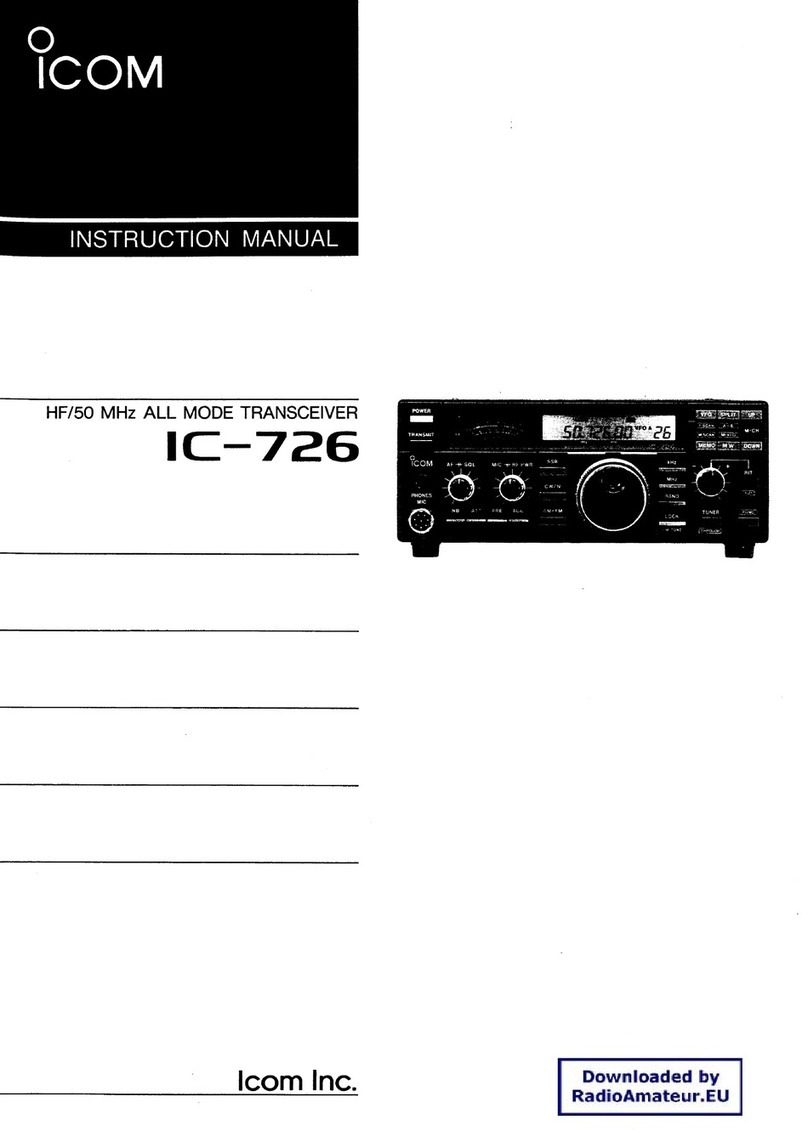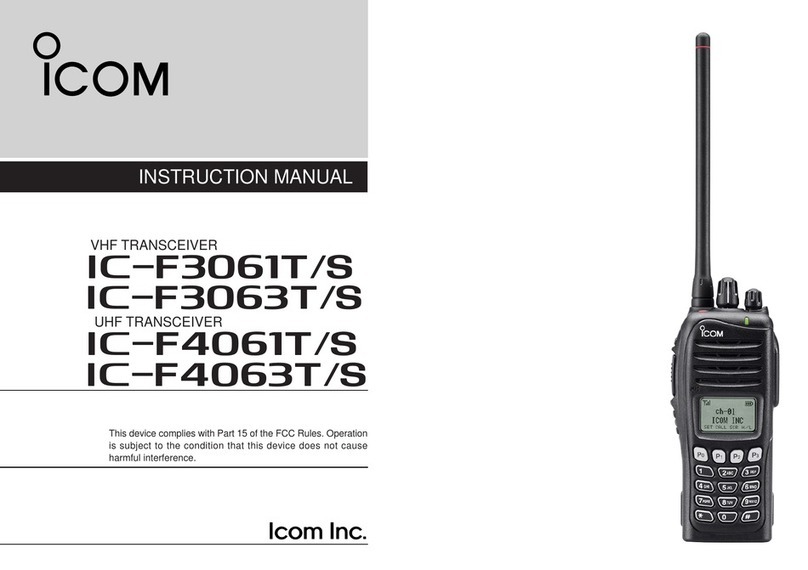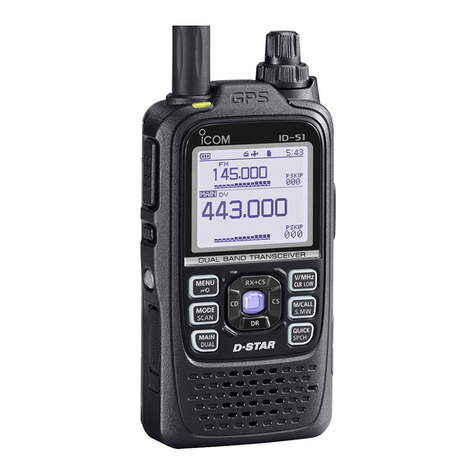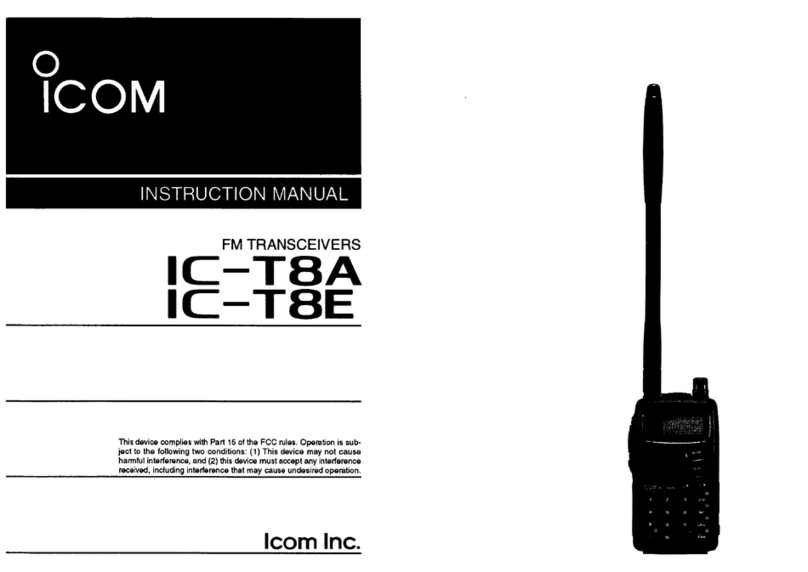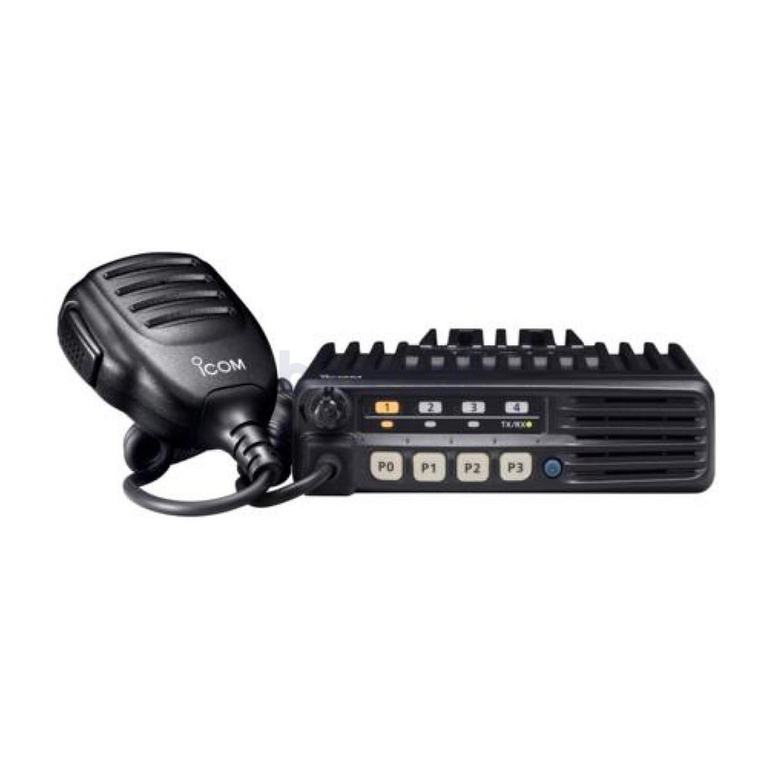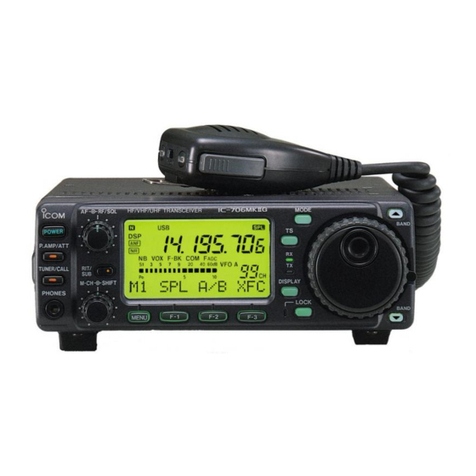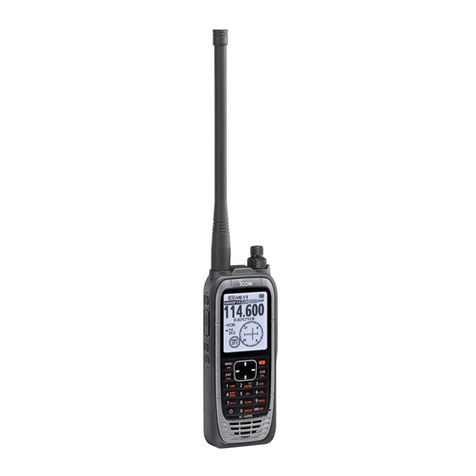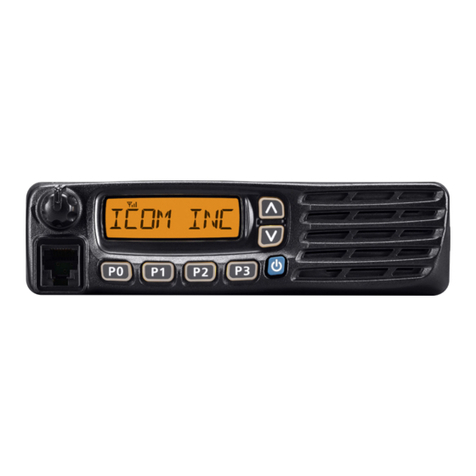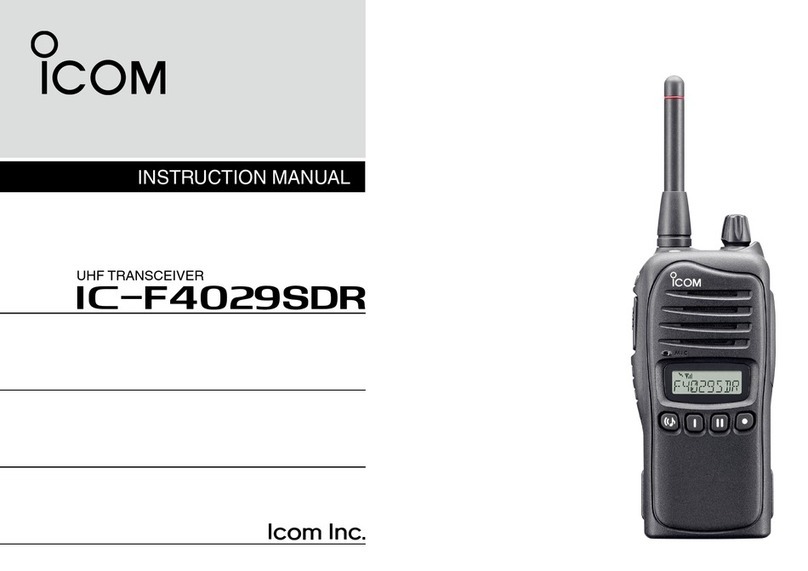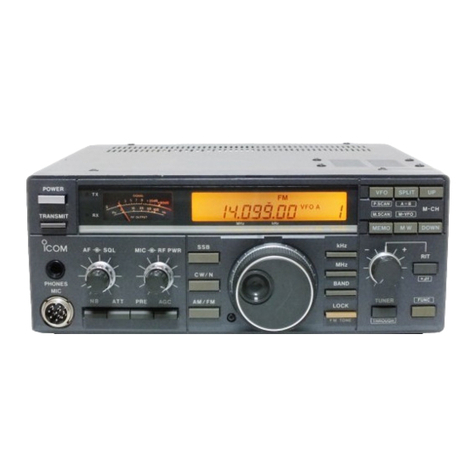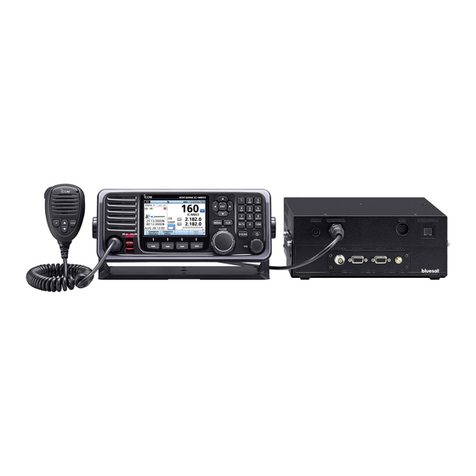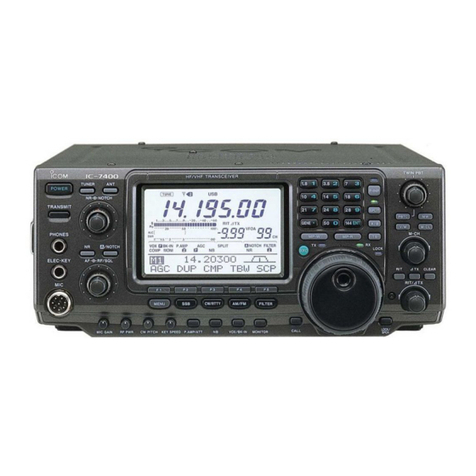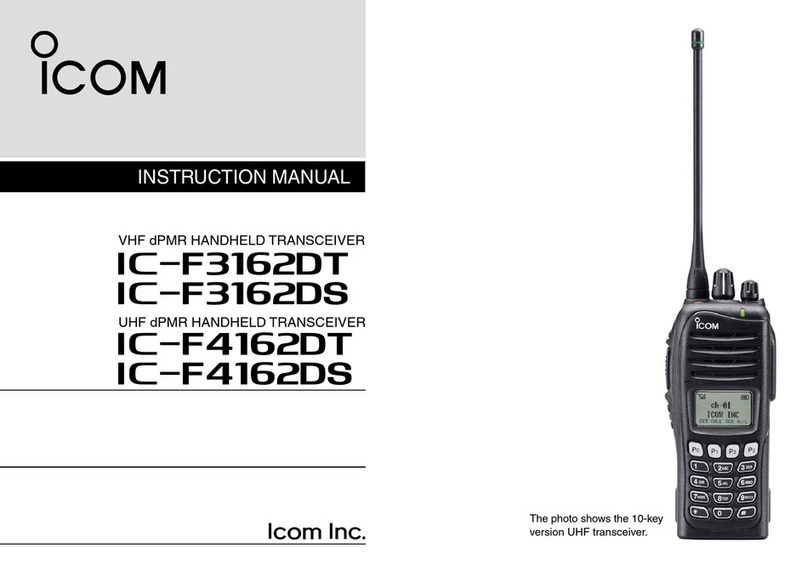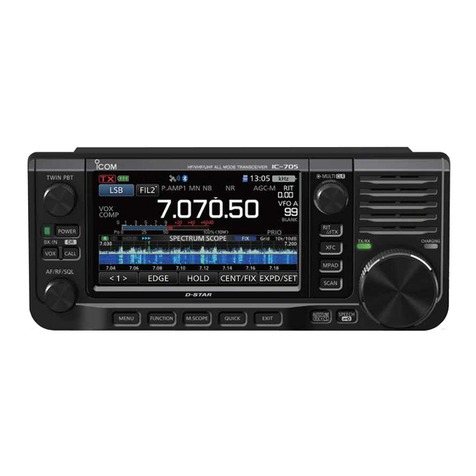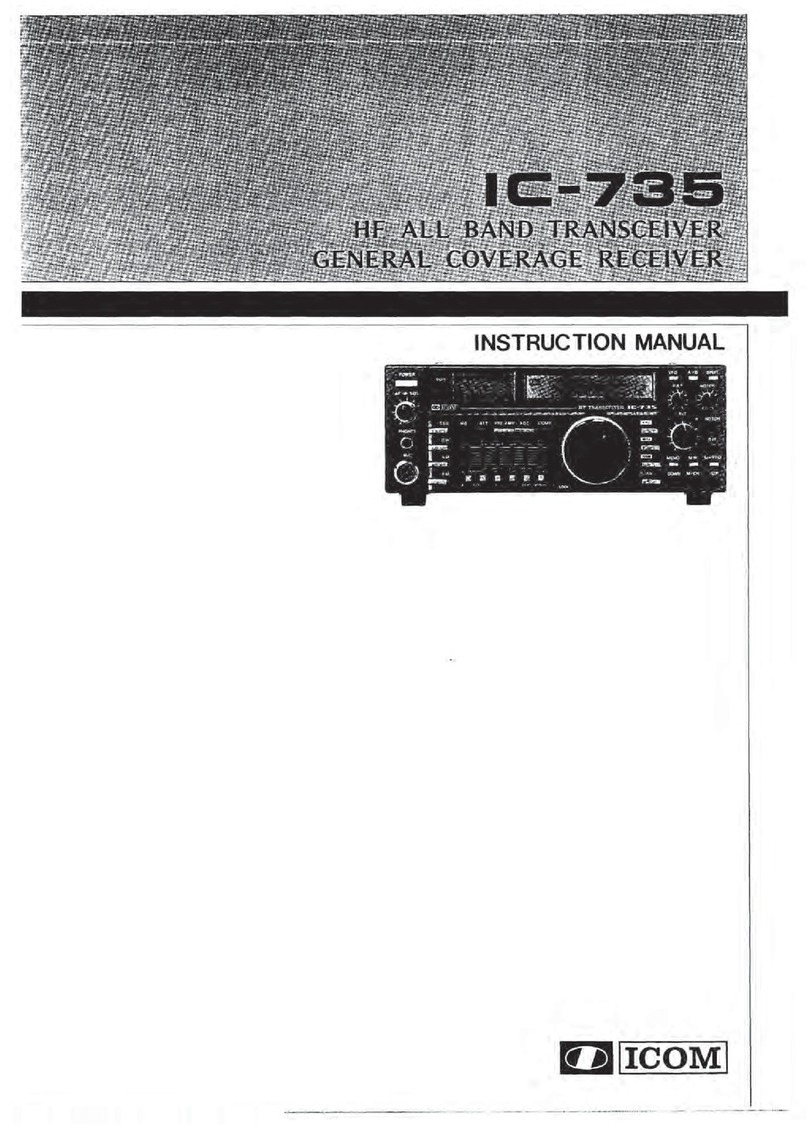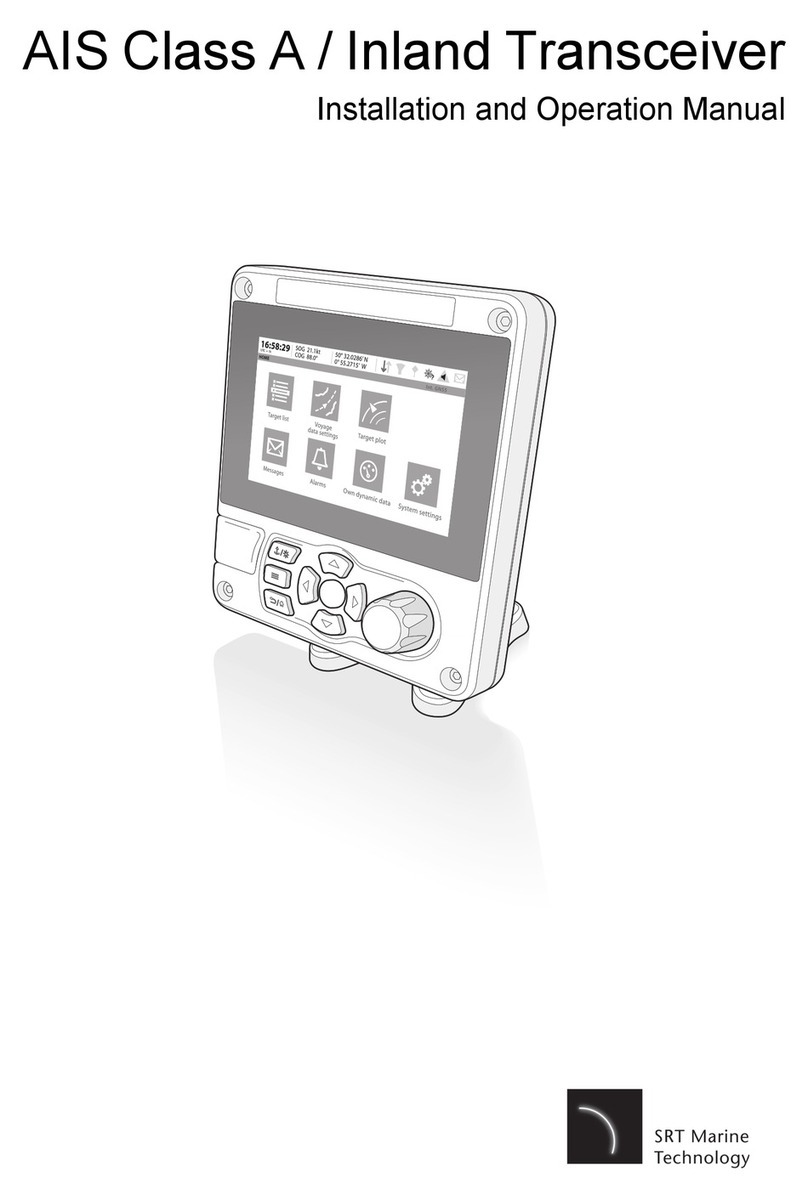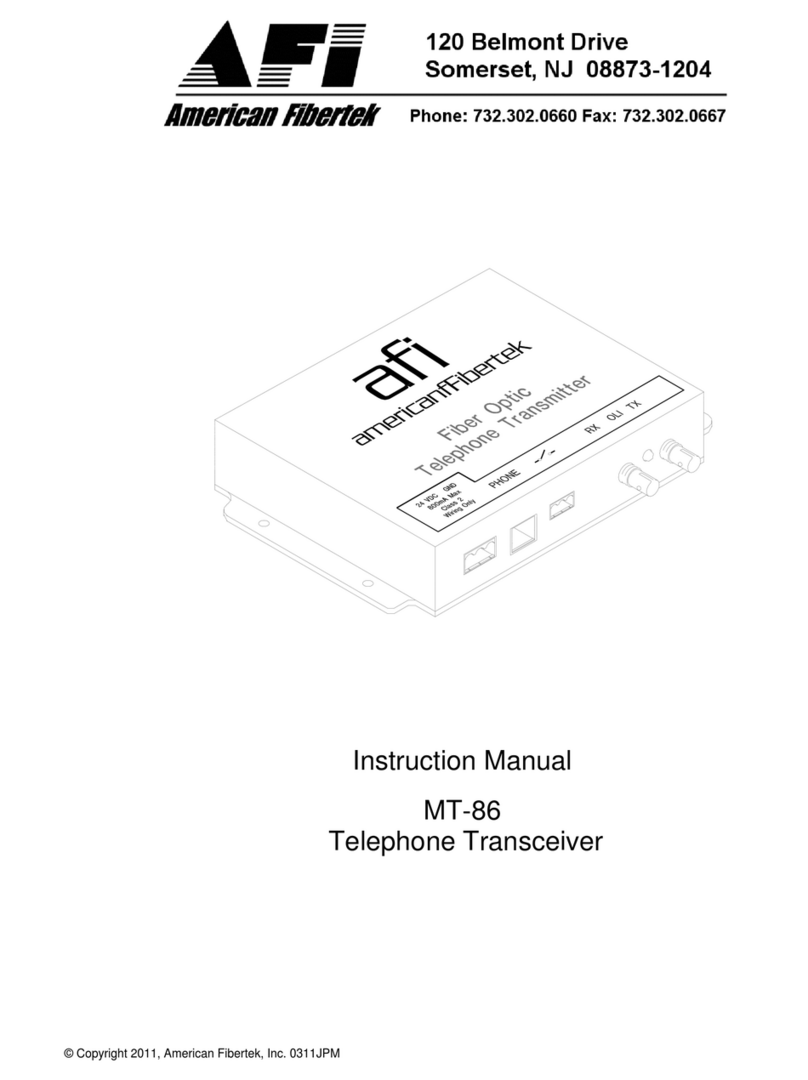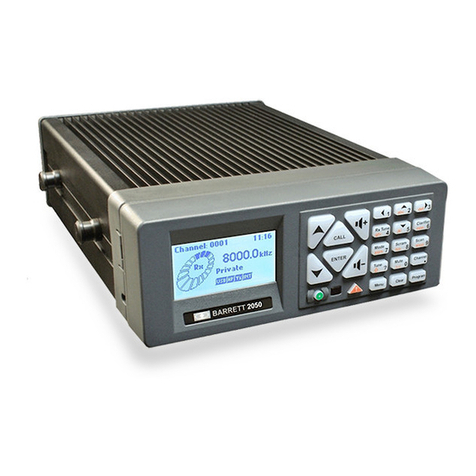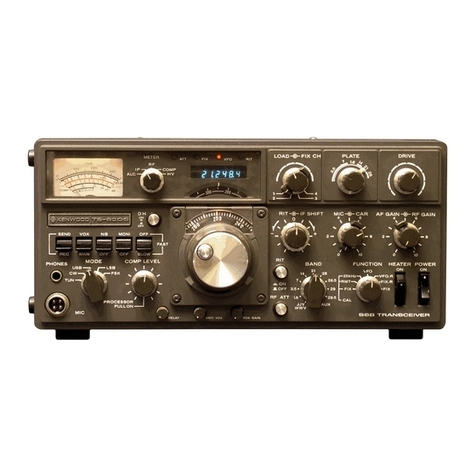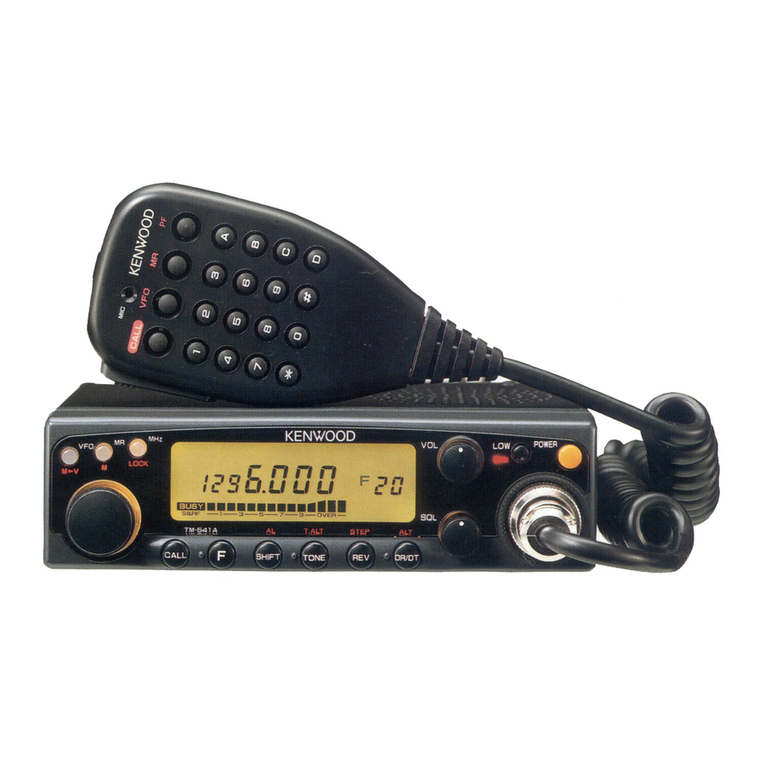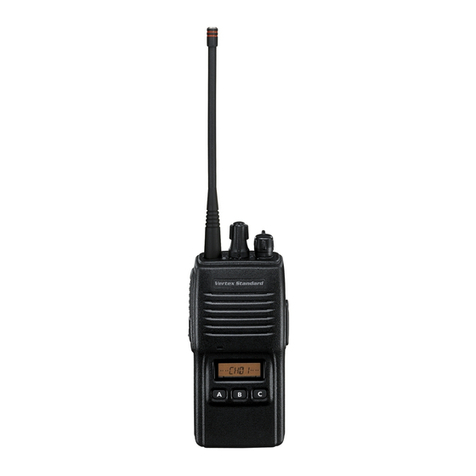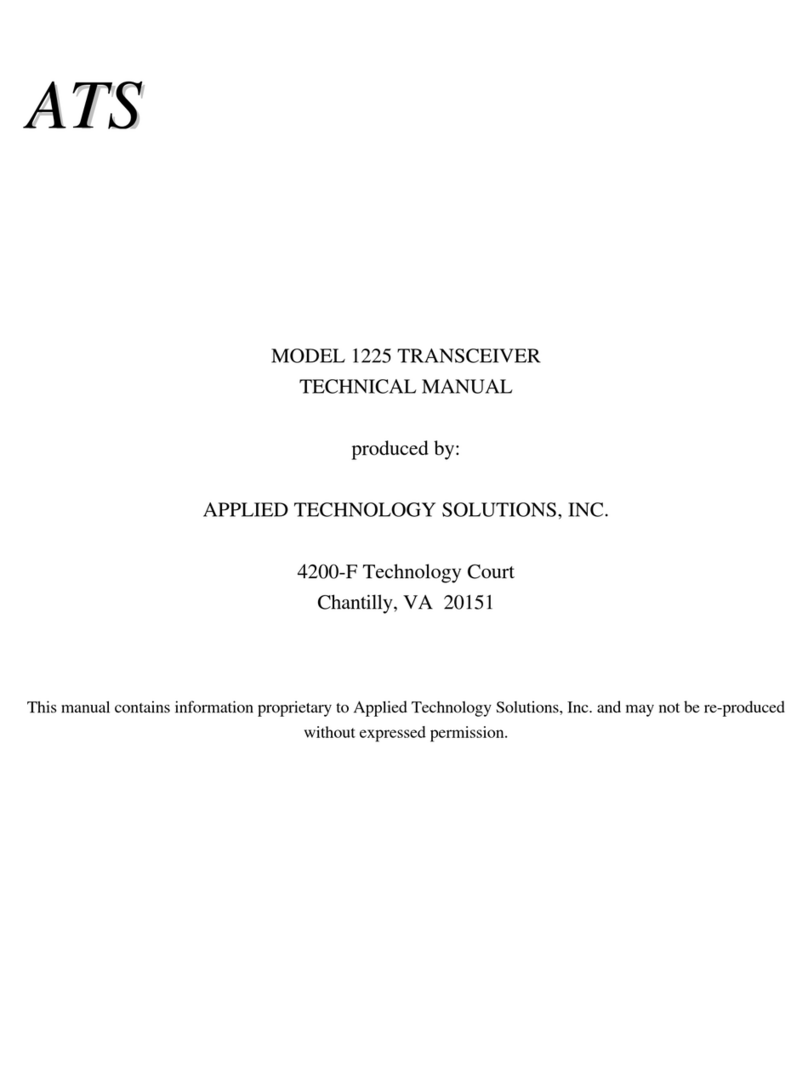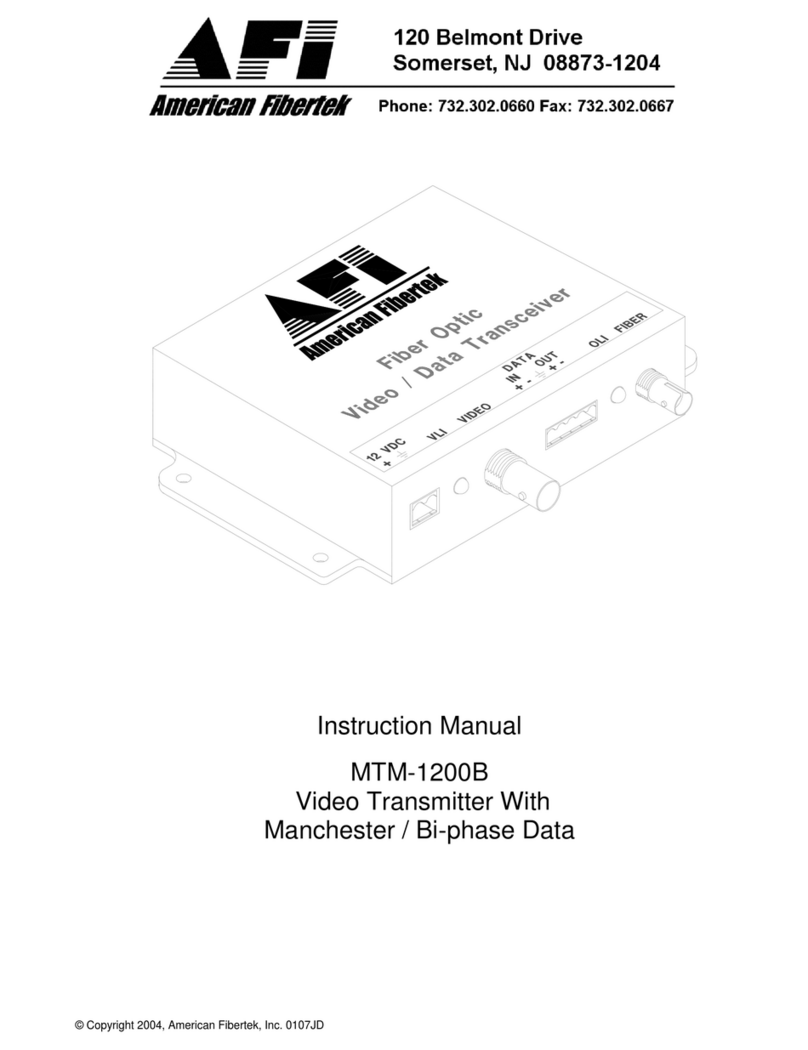Icom IC-2300H User manual

q POWER KEY [ ]
Hold down for 1 second to turn power ON or OFF.
w MEMORY WRITE KEY [S.MW MW]
➥Push to enter the memory write mode.
➥Hold down for 1 second to program the selected mem-
ory channel.
• Continue to hold down the key to automatically incre-
ment the memory channels.
eMICROPHONE CONNECTOR
Connect the supplied microphone here.
r VOLUME CONTROL [VOL]
Rotate to adjust the audio level.
t SQUELCH CONTROL [SQL]
Rotate to adjust the squelch level.
• The S-meter squelch or attenuator squelch is activated,
when you rotate [SQL] clockwise from the center position.
ySET•LOCK KEY [SET LOCK]
➥Push to enter to the Set mode.
➥
Hold down for 1 second to turn the Lock function ON or OFF.
u
MONITOR•CHANNEL NAME•PA KEY [MONI ANM PA]
➥Push to turn the monitor function ON or OFF.
➥In the memory or Call channel mode, hold down for 1
second to turn the channel name or number ON or OFF.
➥In the marine channel mode, hold down for 1 second to
turn ON the Public Address function.
iOUTPUT POWER•DUPLEX KEY [LOW DUP]
➥Push to select the output power.
➥Hold down for 1 second to select the minus duplex,
plus duplex or simplex mode.
oTONE•TONE SCAN KEY [TONE T-SCAN]
➥Push to select the tone function.
➥Hold down for 1 second to start a Tone Scan.
!0 MEMORY/CALL•PRIORITY KEY [M/CALL PRIO]
➥Push to select and toggle memory, Call and marine
channel modes.
➥Hold down for 1 second to start a priority watch.
!1 VFO/MHz TUNING•SCAN KEY [V/MHz SCAN]
➥Push to select the VFO mode.
• In the VFO mode, push to select the tuning step.
➥Hold down for 1 second to start a scan.
• Push to cancel an active scan.
!2 BANK•OPTION KEY [BANK OPT]
➥Push to select a memory bank in the memory mode.
➥Hold down for 1 second to enter the Option Set mode.
• In the marine channel mode, hold down for 1 second
to enter the Marine Set mode.
!3 TUNING DIAL [DIAL]
➥Selects the operating frequency, memory channel.
➥Selects an item in the Set mode.
➥Changes the scanning direction.
D Microphone connector (front panel view)
q+8 V DC output (Max. 35 mA)
wChannel up/down
e8 V control IN
rPTT
tGND (microphone ground)
yMIC (microphone input)
uGND
iData IN
INSTRUCTIONS
FM TRANSCEIVER
i2300H
Thank you for purchasing the IC-2300H FM TRANSCEIVER
with Icom’s state of the art technology.
Please read all instructions carefully before using the IC-
2300H.
■Panel description— Front panel
■Panel description— Function display
qFREQUENCY READOUT
Displays the operating frequency, channel name, Set
mode contents, and so on.
• The frequency decimal point blinks during a scan.
• While the DTMF memory function is in use, “d” appears
in the 100 MHz digit.
wTRANSMIT ICON
➥Appears while transmitting.
➥Blinks while transmitting with the One-Touch PTT func-
tion ON.
eAUDIO MUTE ICON
Appears when the Audio Mute function is activated.
rNARROW MODE ICON
Appears when the narrow FM mode is selected.
tOUTPUT POWER ICONS
Displays the selected transmit output power level.
yKEY ICONS
Displays the function(s) of the front panel keys directly
below the function display.
uSKIP ICON
Appears when the selected memory channel is set as a
skip channel.
iMEMORY CHANNEL NUMBER READOUT
➥Displays the selected memory channel number.
➥“C” appears when the Call channel is selected.
oMEMORY ICON
Appears when the Memory mode is selected.
!0 S/RF INDICATOR
➥
Displays the relative signal strength, while receiving signals.
➥Displays the output power level, while transmitting.
!1 BUSY ICON
➥Appears when receiving a signal, or the squelch is open.
➥Blinks while the monitor function is turned ON.
!2 S-METER SQUELCH ICON
Appears while the S-meter Squelch function is turned ON.
!3 SQUELCH ATTENUATOR ICON
Appears while the Squelch Attenuator function is turned ON.
!4 PRIORITY WATCH ICON
Appears during Priority Watch.
!5 AUTO POWER OFF ICON
Appears when the Auto Power OFF function is turned ON.
!6 TONE ICONS
➥ The “ ” icon appears while the subaudible tone en-
coder is in use.
➥ The “ ” and “ ” icons appear while the DTCS encoder
is in use.
➥ The “ ” icon appears while the Tone Squelch (CTCSS)
function is in use.
➥ The “ ” and “ ” icons appear while the Reverse Tone
Squelch (CTCSS) function is in use.
➥ The “ ” icon appears while the Tone Squelch (DTCS)
function is in use.
➥ The “ ” and “ ” icons appear while the Reverse Tone
Squelch (DTCS) function is in use.
➥ The “ ” icon appears with the “ ” or “ ” icon, while the
pocket beep function (CTCSS or DTCS) is in use.
!7 DUPLEX ICONS
The “+” icon appears in the plus duplex mode, and the “–”
icon appears in the minus duplex mode.
!8 FOGHORN ICON
Appears while the Foghorn function is turned ON.
!9 LOCK ICON
Appears while the Lock function is turned ON.
■Precautions
RWARNING RF EXPOSURE! This device emits Ra-
dio Frequency (RF) energy. Extreme caution should be observed
when operating this device. If you have any questions regarding RF
exposure and safety standards, please refer to the Federal Com-
munications Commission Office of Engineering and Technology’s
report on Evaluating Compliance with FCC Guidelines for Human
Radio frequency Electromagnetic Fields (OET Bulletin 65).
RWARNING! NEVER connect the transceiver to an AC
outlet. This may pose a fire hazard or result in an electric shock.
RWARNING! NEVER cut the DC power cable be-
tween the DC plug and fuse holder. If an incorrect connection is
made after cutting, the transceiver may be damaged.
RWARNING! NEVER operate the transceiver while
driving a vehicle. Safe driving requires your full attention—any-
thing less may result in an accident.
RWARNING! NEVER connect the transceiver to a
power source of more than 16 V DC or use reverse polarity. This
could cause a fire or damage the transceiver.
RWARNING! NEVER operate or touch the transceiver
with wet hands. This may result in an electric shock or damage
the transceiver.
RWARNING! NEVER place the transceiver where
normal operation of the vehicle may be hindered or where it
could cause bodily injury.
RWARNING! NEVER let metal, wire or other objects
touch any internal part of the transceiver. This may result in an
electric shock.
CAUTION: NEVER expose the transceiver to rain, snow
or any liquids. The transceiver may be damaged.
DO NOT push the PTT when not actually intending to transmit.
KEEP the transceiver out of the reach of children.
During mobile operation, DO NOT operate the transceiver
without running the vehicle’s engine. When the transceiver’s
power is ON and your vehicle’s engine is OFF, the vehicle’s bat-
tery will soon become exhausted.
BE CAREFUL! The transceiver will become hot when op-
erating it continuously for long periods of time.
DO NOT set the transceiver in a place without adequate ven-
tilation. Heat dissipation may be affected, and the transceiver
may be damaged.
DO NOT use or place the transceiver in direct sunlight or in areas
with temperatures below –10°C (+14˚F) or above +60°C (+140˚F).
DO NOT use harsh solvents such as benzine or alcohol
when cleaning, as they will damage the transceiver’s surfaces.
USE only Icom microphones (supplied or optional). Other
manufacturer’s microphones have different pin assignments and
may damage the transceiver if attached.
Approved Icom optional equipment is designed for optimal per-
formance when used with an Icom transceiver.
Icom is not responsible for the destruction or damage to an Icom
transceiver in the event the Icom transceiver is used with equip-
ment that is not manufactured or approved by Icom.
This instruction sheet describes only basic operations. For more detailed instructions, go to our web site (URL: http://www.icom.
co.jp/world/index.html) to view or download the full IC-2300H instruction manual.
In the instruction manual, some options or some functions may not be available for this version. Please ask your dealer for details.
Turning power ON/OFFD
➥Hold down [ ] for 1 second to turn the power ON or OFF.
D VFO mode selection
The IC-2300H has two basic operating modes; the VFO
mode and the memory mode.
➥Push [V/MHz] to select the VFO mode.
•Push [M/CALL] one or more times to select the memory,
Call or marine channel* mode.
DSetting a frequency
qIf necessary, push [V/MHz] to select the VFO mode.
wRotate [DIAL] to set the frequency.
•
The frequency changes according to the selected tuning step.
• Push [V/MHz] one or more times, to toggle the frequency
step between 1 MHz and 10 MHz, if desired.
DTuning step selection
The tuning step is the smallest selectable frequency incre-
ment you can use to set the operating frequency. The follow-
ing tuning steps are selectable.
• 5 kHz• 6.25 kHz• 10 kHz• 12.5 kHz• 15 kHz
• 20 kHz• 25 kHz• 30 kHz• 50 kHz
NOTE: For convenience, select the tuning step that match-
es the frequency intervals of the repeaters in your area.
qIf necessary, push [V/MHz] to select the VFO mode.
wPush [SET] to enter the Set mode.
e
Push [SET] or [MONI] one or more times, until “TS” appears.
rRotate [DIAL] to select the desired tuning step.
tPush any key, other than [SET] or [MONI], to save the
entry and exit the Set mode.
DCall channel selection
➥
Push [M/CALL] one or more times to select the Call channel.
• “C” appears instead of a memory channel number.
• Push [M/CALL] to select the marine channel* mode, push
again to return to the memory mode, or push [V/MHz] to
select the VFO mode.
DLock function
Use the Lock function to prevent accidental channel changes
and unnecessary function access.
➥Hold down [LOCK] (SET) for 1 second to turn the Lock
function ON or OFF.
• [PTT], [MONI], [VOL] and [SQL] can be used, even
while the Frequency Lock function is ON.
DMonitor function
This function is used to listen to weak signals without dis-
turbing the squelch setting, or to open the squelch manually,
even when the tone squelch is in use.
➥Push [MONI] to open the squelch.
• The “BUSY” icon blinks.
• Push [MONI] again to cancel the function.
DSquelch attenuator
The transceiver has an RF attenuator related to the squelch
level setting. Approximately 20 dB of attenuation is obtained
at the maximum setting.
Turn ON the Squelch Attenuator function:
qPush [ ] to turn OFF the power.
wWhile holding down [LOCK] (SET), hold down []for
1 second to turn ON the power and enter the Initial Set
mode.
ePush [SET] or [MONI] one or more times, to select the "SQL"
item.
rRotate [DIAL] to select "AT" (Attenuator).
tPush []to save and exit the Initial Set mode.
yRotate [SQL] clockwise past the 12 o’clock position, to
activate the squelch attenuator.
• The attenuation level can be adjusted up to approximate-
ly 20 dB, between the 12 o’clock and fully clockwise posi-
tions.
• When setting the squelch from the microphone, a level
greater than ‘17’ activates the attenuator.
NOTE: When using with the Monitor function.
The squelch attenuator functions even when the Monitor
function is in use. It is recommended to set [SQL] be-
tween 10 and 12 o’clock (7 to 17 level when it is set using
the HM-133V).
DS-meter squelch
The transceiver has an S-meter squelch. The S-meter
squelch allows you to set minimum signal level needed to
open the squelch.
Turn ON the S-meter squelch function:
qPush [ ] to turn OFF the power.
wWhile holding down [LOCK] (SET), hold down []for 1 sec-
ond to turn ON the power and enter the Initial Set mode.
ePush [SET] or [MONI] one or more times, to select the
"SQL" item.
rRotate [DIAL] to select "SS" (S-meter squelch).
tPush []to exit the Initial Set mode.
yRotate [SQL] clockwise past the 12 o’clock position, to
activate the S-meter squelch.
DSelecting output power
Set the output power level to suit your operating require-
ments. Lower output power during short-distance commu-
nications may reduce the possibility of interference to other
stations and will reduce current consumption.
➥Push [LOW] one or more times to select the output pow-
er.
• The power level can be changed even while transmitting.
*: Transmission is inhibited in the marine channel mode.
Basic operation■
qVFO/LOCK KEY [VFO/LOCK]
➥Push to select the VFO mode.
➥Hold down for 1 second to turn the Lock function ON or
OFF.
wPTT SWITCH
➥Hold down to transmit; release to receive.
➥Toggles between transmitting and receiving while the
One-Touch PTT function is in use.
eUP/DOWN KEYS [Y]or [Z]
➥Push either key to change the operating frequency,
memory channel, mode setting, and so on.
➥Hold down either key for 1 second to start scanning.
rACTIVITY INDICATOR
➥Lights red while any key other than [FUNC] and
[DTMF-S] , is pushed, or while transmitting.
➥Lights orange while the Microphone Keypad Lock func-
tion is activated.
➥Lights green while the One-Touch PTT function is in use.
tKEYPAD
➥Push the keys to activate various functions.
yFUNCTION INDICATOR
➥Lights orange while [FUNC] is activated—indicat-
ing the secondary function of keys can be accessed.
➥Lights green when [DTMF-S] is activated—DTMF
signals can be transmitted using the keypad.
uFUNCTION KEY [FUNC]
iDTMF MEMORY SELECT KEY [DTMF-S]
oFUNCTION KEYS [F-1] or [F-2]
Program and recall your desired transceiver setting.
!0 BANK/OPTION KEY [BANK/OPTION]
➥
In the memory mode, push to select the memory bank option.
➥Hold down for 1 second to enter the Option Set mode.
• In the marine channel mode, hold down for 1 second to
enter the Marine Set mode.
➥In the Marine Set mode, push to select the next item.
!1 MEMORY/CALL KEY [MR/CALL]
➥Push to select the memory mode.
➥Hold down for 1 second to select the Call channel.
➥In the Marine Set mode, push to select the previous item.
■HM-133V keypad
KEY FUNCTION SECONDARY FUNCTION ( +key) OTHER FUNCTION
Opens and closes the squelch. Turns the channel names or number display ON or OFF,
in the memory mode. After pushing, transmits
the appropriate DTMF code.
When the DTMF memory
encoder is activated, push
[A] to [D], [M], [#], [0] to [9]
to transmit the appropriate
DTMF memory contents.
Starts and stops scanning. Starts and stops tone scanning.
Starts and stops priority watch. Turns the One-Touch PTT function ON or OFF.
Selects high output power. Turns ON the DTCS squelch.
Selects mid output power. Turns ON the DTCS pocket beep function.
Selects low output power. Turns ON the DTMF memory encoder function.
Selects the minus duplex mode. Turns ON the subaudible tone encoder.
Selects the plus duplex mode. Turns ON the CTCSS pocket beep function.
Selects the simplex mode. Turns ON the tone squelch function.
Adjusts the audio level. Sends a 1750 Hz tone signal while held down.
➥ Cancels frequency entry.
➥Cancels a scan or priority watch.
➥ Exits the Set mode.
➥Selects the memory channel programming mode.
➥Advances the memory channel number when con-
tinuously pushed after programming is completed.
➥Enters the Set mode.
➥Selects the next item in the Set mode.
Turns OFF the DTMF memory mode.
➥Sets the keypad for numeral input.
➥Selects the previous item in the Set mode.
Turns OFF the subaudible tone encoder, pocket beep or
CTCSS/DTCS tone squelch.
Adjusts the squelch level. Mutes the audio.
• The Mute function is released when any operation is
performed.
Adjusts the audio level. Sends a 1750 Hz tone signal for 1 second.
Adjusts the squelch level. Locks the digit keys on the keypad (including the [A] to
[D], [#] and [M]keys).
• The activity indicator lights orange while the Micro-
phone Keypad Lock function is activated.
!7 !3
!4
!5
!6 !2 !1
!9 !8
i
!0
u
o
w
y
t
e
r
q
[ ]
[S.MW] (MW)
[SET] (LOCK)
[MONI] (ANM PA)
[LOW] (DUP) [TONE] (T-SCAN)
[M/CALL] (PRIO)
[V/MHz] (SCAN)
[BANK] (OPT)
[SQL]
[DIAL]
[VOL]
S.MW
SQL
VOL
MW
BANK
OPT
Function display
!0
o
i
u
y
q
w
e
rt!1 !2
!3
qi
Squelch is
open.
Squelch attenuator
or
S-meter squelch
Squelch
threshold
Shallow Deep
Noise squelch • [SQL] control
■Microphone (HM-133V)
q
e
r
t
Mic element
y
u
i
o
!0
!1
w

A-6966H-3EX
Printed in Japan
© 2011 Icom Inc.
1-1-32 Kamiminami, Hirano-ku, Osaka 547-0003, Japan
Printed on recycled paper with soy ink.
PreparationD
If desired, set the scan resume option, program the
scan edges, program 2 or more memory channels, and
set the skip channels.
OperationD
qSelect the mode or bank.
For full/programmed scan:
➥Push [V/MHz] to select the VFO mode.
For memory or TAG channel scan:
➥ Push [M/CALL] one or more times to select the mem-
ory or marine channel mode.
For bank scan:
➥ Push [BANK], and then rotate [DIAL] to select the de-
sired bank.
wSet the squelch to the point where the noise is just muted.
eHold down [SCAN] (V/MHz) for 1 second to start a scan.
• Rotate [DIAL] to change the scanning direction.
• Except for memory and TAG channel scans, the scan
type blinks in the memory channel readout:
• During a full scan, push [SET] to switch between a full
scan and a programmed scan (P1, P2 and P3).
• Push [V/MHz] to cancel the scan.
• Set mode setting
qPush [SET] to enter the Set mode.
wPush [SET] or [MONI] to select a desired item.
eRotate [DIAL] to select an option or value.
rPush any key other than [SET] or [MONI], to save and
exit the Set mode.
■Scan start/stop
■Set mode
Set the backlight brightness.
Set the Auto Dimmer brightness.
Select the display backlight color.
Adjust the LCD contrast.
Turn the TX inhibit function ON or OFF.
(Select “OFF” to inhibit transmitting.)
Turn the Skip function ON or OFF.
Assign the desired memory
and scan edge channels.
Assign the desired banks
for a continuous banks scan.
Set both the transmit
and receive passband.
Set the microphone sensitivity.
Select the subaudible tone
needed to access the repeater.
Select the CTCSS tone frequency
for the tone squelch function.
Set the DTCS code
for DTCS squelch use.
Set the Transmit
and Receive DTCS polarity.
Set the duplex frequency offset.
Turn the Reverse Duplex
function ON or OFF
Set the VFO tuning step.
Select the scan pause timer option.
Select the resume options of a scan pause.
• Auto dimmer
• Display dimmer
Set mode items
• Display color
• Display contrast
• Repeater tone frequency
• Tone squelch frequency
• DTCS code
• DTCS polarity
• Frequency offset
• Tuning step
• Reverse mode
• Scan resume timer
• Scan stop timer
• Channel skip setting†
• Bank link function
†
• MIC gain
• Bank setting†
• Wide/Narrow
• Transmit permission
:
[SET]
:
[MONI]
†Appears only when accessing the Set mode from the memory mode.
S
E
TMONI
S
E
TMONI
S
E
TMONI
S
E
TMONI
S
E
TMONI
S
E
TMONI
S
E
TMONI
S
E
TMONI
S
E
TMONI
S
E
TMONI
S
E
TMONI
S
E
TMONI
S
E
TMONI
S
E
TMONI
S
E
TMONI
S
E
TMONI
S
E
TMONI
S
E
TMONI
S
E
TMONI
Initial Set mode■
Initial Set mode items
:
[SET]
:
[MONI]
LOCK
S
E
T
ANM
MONI
DUP
LOW
T-SCAN
TONE
DIGITAL
MUTE
NAR
MID
LOW
LOCK
S
E
T
ANM
MONI
DUP
LOW
T-SCAN
TONE
DIGITAL
MUTE
NAR
MID
LOW
LOCK
S
E
T
ANM
MONI
DUP
LOW
T-SCAN
TONE
DIGITAL
MUTE
NAR
MID
LOW
LOCK
S
E
T
ANM
MONI
DUP
LOW
T-SCAN
TONE
DIGITAL
MUTE
NAR
MID
LOW
LOCK
S
E
T
ANM
MONI
DUP
LOW
T-SCAN
TONE
DIGITAL
MUTE
NAR
MID
LOW
LOCK
S
E
T
ANM
MONI
DUP
LOW
T-SCAN
TONE
DIGITAL
MUTE
NAR
MID
LOW
LOCK
S
E
T
ANM
MONI
DUP
LOW
T-SCAN
TONE
DIGITAL
MUTE
NAR
MID
LOW
LOCK
S
E
T
ANM
MONI
DUP
LOW
T-SCAN
TONE
DIGITAL
MUTE
NAR
MID
LOW
LOCK
S
E
T
ANM
MONI
DUP
LOW
T-SCAN
TONE
DIGITAL
MUTE
NAR
MID
LOW
LOCK
S
E
T
ANM
MONI
DUP
LOW
T-SCAN
TONE
DIGITAL
MUTE
NAR
MID
LOW
• Key-touch beep
Turn the confirmation beeps
ON (default) or OFF.
Inhibit continuous transmissions
longer than the set time period.
Automatically turn
the transceiver’s power OFF.
Set the transmission lockout capability.
Set the squelch delay to “S” (Short) or
“L” (Long).
Set the squelch type to “OFF” (Noise squelch),
“SS” (S-meter Squelch) or
“AT” (Squelch Attenuator).
Turn the Tone Burst function ON or OFF.
Set the DTMF sending rate to 1–3 or 5.
Set the display type
while in the memory mode.
Turn the Voltage Display
function ON or OFF.
• Time-out timer
• Auto power OFF
• Repeater lockout
• Squelch delay
• Squelch type
• Tone burst
• DTMF speed
• Display type
• Voltage display
1. Setting duplex
Hold down [DUP] (LOW) for 1 second once or twice to se-
lect minus duplex or plus duplex.
2. Repeater tone
If accessing the repeater requires a subaudible tone, push
[TONE] one or more times until “ ” appears.
The IC-2300H has a total of 207 memory channels for stor-
ing often used operating frequencies, repeater settings, and
so on. Memories include 6 scan edges and 1 Call channel.
PROGRAMMING MEMORY CHANNELSD
1. Setting the frequency
In the VFO mode, set the desired operating frequency, re-
peater, tone, tuning steps, and so on.
2. Selecting the memory channel
Push [S.MW], and then rotate [DIAL] to select the desired
memory channel.
• The “ ” icon and memory channel number blink.
3. Writing the memory channel
Hold down [MW] (S.MW) for 1 second to program.
• 3 beeps sound
• The memory channel number automatically increases when
continuing to hold down [MW] (S.MW) after programming.
DSelecting Memory channel
qPush [M/CALL] one or more times to select the memory
mode.
• The “ ” icon appears.
wRotate [DIAL] to select a desired memory channel.
• Only programmed memory channels can be selected.
D Selecting a marine channel
qPush [M/CALL] one or more times to select the marine
channel mode.
LOCK
S
E
T
ANM
MONI
DUP
LOW
T-SCAN
TONE
PRIO
M/CALL
SCAN
V/MHz
DIGITAL PRIO AO BUSY
MUTE
NAR
MID
LOW
Appears
Appears
w
Rotate
[DIAL]
to select the desired channel.
D Setting TAG channels
Marine channels; 09 and 16 are preprogrammed as TAG
channels. You can set other marine or memory channels as
TAG channels.
NOTE: Only TAG channels are selectable in the marine
channel mode.
qPush [M/CALL] one or more times to select the marine
channel mode.
wPush [S.MW].
LOCK
S
E
T
ANM
MONI
DUP
LOW
T-SCAN
TONE
PRIO
M/CALL
SCAN
V/MHz
DIGITAL PRIO AO BUSY
MUTE
NAR
MID
LOW
eRotate [DIAL] to select a marine or memory channel to
be added.
LOCK
S
E
T
ANM
MONI
DUP
LOW
T-SCAN
TONE
PRIO
M/CALL
SCAN
V/MHz
DIGITAL PRIO AO BUSY
MUTE
NAR
MID
LOW
Selected
channel
rHold down [MW] (S.MW) for 1 second.
• 3 beeps sound and the selected channel is added.
D Clearing TAG channels
The programmed TAG channels can be cleared as a TAG channel.
qPush [M/CALL] one or more times to select the marine
channel mode.
wRotate [DIAL] to select the marine channel to be cleared.
eHold down [MW] (S.MW) for 1 second.
• 3 beeps sound and the selected channel is cleared.
D Setting the Call/Priority channel
Set a TAG channel as the Call or Priority channel.
qPush [M/CALL] one or more times to select the marine
channel mode.
wHold down [OPT] (BANK) for 1 second, to enter the Ma-
rine Set mode.
ePush [SET] or [MONI] until the “M–” and “C” or “M–” and
“P” appear.
LOCK
S
E
T
ANM
MONI
DUP
T-SCAN
SCAN
DIGITAL PRIO AO BUSY
MUTE
NAR
MID
LOW
LOCK
S
E
T
ANM
MONI
DUP
T-SCAN
PRIO
SCAN
DIGITAL PRIO AO BUSY
MUTE
NAR
MID
LOW
Setting the Priority channel
Setting the Call channel
rRotate [DIAL] to select the channel to set as the Call or
Priority channel.
tPush any key other than [SET], [MONI] or [BANK], to
save the setting and exit the Marine Set mode.
D Priority watch, Dualwatch/Tri-watch
• Priority watch
A priority watch
sequentially
searches through
all TAG channels,
while also moni-
toring the Priority
channel. When a
signal is detect-
ed on the Prior-
ity channel, the
watch pauses until the signal disappears; when a signal is
detected on a channel other than the Priority channel, the
Priority watch switches to Dualwatch, until the signal disap-
pears.
• Dualwatch
Dualwatch monitors the Pri-
ority channel while receiving
on a TAG channel. The watch
pauses when a signal is received on the Priority channel.
• Tri-watch*
Tri-watch monitors the
Priority channel and
the Call channel while
receiving on a TAG
channel.
Tri-watch switches to
Dualwatch, when receiving a signal on the Call channel.
*One or more TAG channels other than the Call and Priority chan-
nels must be programmed, to start the Tri-watch.
Start the watch:
qPush [M/CALL] one or more times to select the marine
channel mode.
wHold down [OPT] (BANK) for 1 second, to enter the Ma-
rine Set mode.
ePush [SET] or [MONI] until “PRI” appears.
rRotate [DIAL] to select the Watch type.
• “PR”: Priority watch
• “DU”: Dualwatch
• “TR” : Tri-watch.
tPush any key other than [SET], [MONI] or [BANK], to
save the setting and exit the Marine Set mode.
yHold down [M/CALL] (PRIO) for 1 second to start the
watch.
• The “PRIO” icon appears.
For only the Dual/Tri-watch:
• Rotate [DIAL] to select the desired TAG channel to re-
ceive.
uTo stop the watch, push [M/CALL].
5 sec. ±1
120 sec.
TYPE PATTERN USAGE
UNDERWAY
"FOG-WA"
One 5-second blast every 120 seconds. Motor vessel underway and making way.
STOP
"FOG-ST"
Two 5-second blasts (separated by 2 sec-
onds) every 120 seconds.
Motor vessel underway but stopped (not
making way).
SAIL
"FOG-SA"
One 5-second blast followed by two
1-second blasts (each separated by 2
seconds) every 120 seconds.
Sailing vessel underway, fishing vessel
(underway or anchored), vessel not under
command, a vessel restricted in her ability
to maneuver (underway or at anchor), or a
vessel towing or pushing another ahead.
TOW
"FOG-TO"
One 5-second blast followed by three
1-second blasts (each separated by
2-seconds) every 120 seconds.
Vessel under tow (manned).
The Foghorn function repeatedly sounds a horn.
qPush [M/CALL] one or more times to select the marine
channel mode.
wHold down [OPT] (BANK) for 1 second, to enter the Ma-
rine Set mode.
ePush [SET] or [MONI] until “FVL” appears.
rRotate [DIAL] to set the output level to 1 (min) to 32 (max).
tPush [SET] or [MONI] until “FREQ” appears.
yRotate [DIAL] to set the horn frequency to 200–850 Hz in
10 Hz steps.
uPush [SET] or [MONI] until “FOG” appears.
iRotate [DIAL] to set the Foghorn pattern.
• Select "OF" to turn OFF the function.
• Refer to the below table for the horn output patterns.
oPush any key other than [SET], [MONI] or [BANK], to
save the setting and exit the Marine Set mode.
• The " " icon blinks while the Foghorn function is ON.
• While sounding a horn, rotate [DIAL] to set the horn out-
putlevel.
The Public Address function is for hailing or making
onboard announcements through a PA speaker.
IMPORTANT: While the Public Address function is turned
ON, the transceiver cannot receive nor transmit signals.
D Setting the Public Address function
qPush [M/CALL] one or more times to select the marine
channel mode.
wHold down [OPT] (BANK) for 1 second, to enter the Ma-
rine Set mode.
ePush [SET] or [MONI] until “PVL” appears.
rRotate [DIAL] to set the output level to between 1 (mini-
mum) and 32 (maximum).
tPush any key other than [SET], [MONI] or [BANK], to
save the setting and exit the Marine Set mode.
D Turning ON the Public Address function
qHold down [PA] (MONI) for 1 second, to turn ON the
Public Address function.
LOCK
S
E
T
ANM
MONI
DUP
LOW
T-SCAN
TONE
PRIO
M/CALL
SCAN
V/MHz
DIGITAL AO BUSY
MUTE
NAR
MID
LOW
• While the Public Address function is ON, only [SET],
[PA] (MONI) and [ ] are usable.
• While holding down [PTT], rotate [DIAL] to set the out-
put level.
wHold down [PTT], and speak into the microphone at a
normal voice level.
• “PA ON” blinks, while holding down [PTT].
eHold down [PA] (MONI) for 1 second again, to turn OFF
the Public Address function.
D Marine Set mode operation
qPush [M/CALL] one or more times to select the marine
channel mode.
wHold down [OPT] (BANK) for 1 second, to enter the Ma-
rine Set mode.
ePush [SET] or [MONI] to select the desired item.
rRotate [DIAL] to select the option or value.
tPush any key other than [SET], [MONI] or [BANK], to
save the setting and exit the Marine Set mode.
D Marine Set mode items
LOCK
S
E
T
ANM
MONI
DUP
T-SCAN
PRIO
SCAN
DIGITAL AO BUSY
MUTE
NAR
MID
LOW
LOCK
S
E
T
ANM
MONI
DUP
T-SCAN
PRIO
SCAN
DIGITAL AO BUSY
MUTE
NAR
MID
LOW
LOCK
S
E
T
ANM
MONI
DUP
T-SCAN
PRIO
SCAN
DIGITAL AO BUSY
MUTE
NAR
MID
LOW
LOCK
S
E
T
ANM
MONI
DUP
T-SCAN
PRIO
SCAN
DIGITAL AO BUSY
MUTE
NAR
MID
LOW
LOCK
S
E
T
ANM
MONI
DUP
T-SCAN
PRIO
SCAN
DIGITAL AO BUSY
MUTE
NAR
MID
LOW
LOCK
S
E
T
ANM
MONI
DUP
T-SCAN
PRIO
SCAN
DIGITAL AO BUSY
MUTE
NAR
MID
LOW
LOCK
S
E
T
ANM
MONI
DUP
T-SCAN
PRIO
SCAN
DIGITAL AO BUSY
MUTE
NAR
MID
LOW
LOCK
S
E
T
ANM
MONI
DUP
T-SCAN
PRIO
SCAN
DIGITAL AO BUSY
MUTE
NAR
MID
LOW
LOCK
S
E
T
ANM
MONI
DUP
T-SCAN
PRIO
SCAN
DIGITAL AO BUSY
MUTE
NAR
MID
LOW
Marine Set mode items
:
[SET]
:
[MONI]
• Priority channel
Set the Priority channel.
Set the Call channel.
• Call channel
• Skip channel
• AF output selections
• Public Address (PA) output level
• Foghorn function
• Foghorn frequency
• Foghorn output level
• Watch type
Turn the channel skip setting ON
or OFF for the channel skip scans
Select the AF output location.
Set the Foghorn pattern to
Underway (“WA”), Stop (“ST”),
Sail (“SA”), Tow (“TO”) or OFF (“OF”).
Set the Foghorn frequency to between
200 and 850 Hz, in 10 Hz steps.
Set the Public Address output level
to between 1 (min) and 32 (max).
Set the foghorn output level
to between 1 (min) and 32 (max).
Set the watch type to Priority
watch (“PR”), Dualwatch (“DU”) or
Tri-watch (“TR”).
■
Memory channels
LOCK
S
E
T
ANM
MONI
DUP
LOW
T-SCAN
TONE
PRIO
M/CALL
SCAN
V/MHz
DIGITAL PRIO AO BUSY
MUTE
NAR
MID
LOW
LOCK
S
E
T
ANM
MONI
DUP
LOW
T-SCAN
TONE
PRIO
M/CALL
SCAN
V/MHz
DIGITAL PRIO AO BUSY
MUTE
NAR
MID
LOW
LOCK
S
E
T
ANM
MONI
DUP
LOW
T-SCAN
TONE
PRIO
M/CALL
SCAN
V/MHz
DIGITAL PRIO AO BUSY
MUTE
NAR
MID
LOW
LOCK
S
E
T
ANM
MONI
DUP
LOW
T-SCAN
TONE
PRIO
M/CALL
SCAN
V/MHz
DIGITAL PRIO AO BUSY
MUTE
NAR
MID
LOW
• During a full scan • During a programmed scan
• During a memory or bank scan
• During a TAG channel scan
The initial Set mode is accessed at power ON, and al-
lows you to set seldom-changed settings. In this way,
you can “customize” the transceiver to suit your prefer-
ence and operating style.
• Initial Set mode operation
qWhile holding down [SET], hold down []for 1 sec-
ond to enter the Initial Set mode.
wPush [SET] or [MONI] to select the desired item.
eRotate [DIAL] to select the option or value.
rPush [ ] to save and exit the initial Set mode.
■Repeater operation
LOCK
S
E
T
ANM
MONI
DUP
LOW
T-SCAN
TONE
PRIO
M/CALL
SCAN
V/MHz
DIGITAL PRIO AO BUSY
MUTE
NAR
MID
LOW
[S.MW] [DIAL]
LOCK
S
E
T
ANM
MONI
DUP
LOW
T-SCAN
TONE
PRIO
M/CALL
SCAN
V/MHz
DIGITAL PRIO AO BUSY
MUTE
NAR
MID
LOW
[TONE]
LOCK
S
E
T
ANM
MONI
DUP
LOW
T-SCAN
TONE
PRIO
M/CALL
SCAN
V/MHz
DIGITAL PRIO AO BUSY
MUTE
NAR
MID
LOW
[DUP] (LOW)
120 sec.
5 sec. ±1
2 sec.
5 sec. ±1
2 sec. 120 sec.
1 sec.
120 sec.
5 sec. ±1
2 sec.
1 sec.
Foghorn function■
Ch 01 Ch 02
Ch 16*
Ch 03
Ch 04
Ch 05
Ch 88
*Priority
channel
Marine channels■(Transmission is inhibited in the marine channel mode.)
• Foghorn patterns
■Marine Set mode ■Public Address (PA) function
AF output selections■
*Priority
channel
Ch 88
Ch 16*
Ch 88
Ch 16†
Ch 88 Ch 9*
*Call channel
†
Priority channel
The IC-2300H has three AF output selections. Select the
output that suits your operating style.
qPush [M/CALL] one or more times to select the marine
channel mode.
wHold down [OPT] (BANK) for 1 second, to enter the Ma-
rine Set mode.
ePush [SET] or [MONI] until “RSP” appears.
rRotate [DIAL] to select the AF output location.
• “OF”: The received AF signal is output from the speaker
jack. (When no external speaker is connected, the
AF signal is output from the internal speaker.)
• “AL” : The received AF signal is output from both inter-
nal speaker and speaker jack.
• “IN” : The received AF signal is output from the internal
speaker.
tPush any key other than [SET], [MONI] or [BANK], to
save the setting and exit the Marine Set mode.
Other manuals for IC-2300H
3
Table of contents
Other Icom Transceiver manuals
